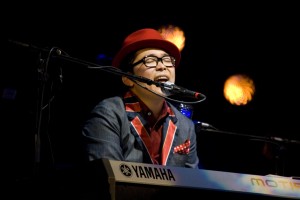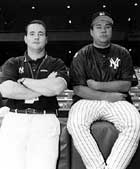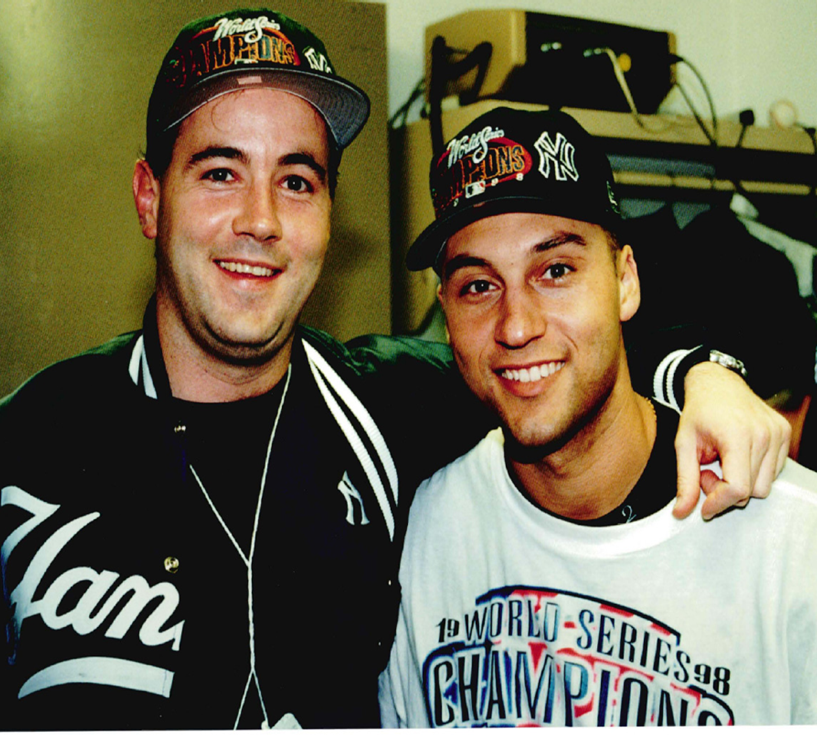Articles by JET journalist Patrick St Michel featured in The Atlantic
Current Mie JET Patrick St. Michel has two articles currently featured in The Atlantic online.
- “The 48 Japanese Schoolgirls Aiming to Take Over the World” – The global ambitions of J-Pop group AKB48
- “How Korean Pop Conquered Japan”
Click here to read other writings by Patrick featured on JETwit.
Return to Tohoku: Update 10.24.11
***************
Here are updates from a few more of the 20 Tohoku region JET alumni selected by the Ministry of Foreign Affairs (MOFA) to return to their town to both engage in volunteer efforts and also help document and share what’s going on there.
- “Back to Iwate“ by Alan Mockridge (Iwate-ken, Ohtsuchi, 1992) – http://alanmockridge.com/ (Lots of excellent photos.)
- Here’s a schedule of Alan’s trip:
Visit schedule
19 Sep (Mon) Depart San Francisco
20 Sep (Tue) Arrive Tokyo
21 Sep (Wed) Briefing at Min. Foreign Affairs. Bullet train to Iwate
22 Sep (Thur) Hiraizumi (UNESCO World Heritage Site) & Morioka
23 Sep (Fri) To Kamaishi via Miyako, Yamada & coast road
24 Sep (Sat) Kamaishi
25 Sep (Sun) Ohtsuchi
26 Sep (Mon) Ohtsuchi High School (cultural exchange)
27 Sep (Tue) Kamaishi to Narita. Depart Japan
JQ Magazine: Concert Review — Japan Society Hosts J-Pop Showcase with Yu Sakai and Cibo Matto
By Vlad Baranenko (Saitama-ken, 2000-02) for JQ magazine. Vlad is an avid photographer.
On Oct. 20, New York’s Japan Society held a sold out co-headlining performance by hometown heroes Cibo Matto and the Japanese singing sensation Yu Sakai in his international debut. Whether an aficionado of jazz, hip-hop, R&B or pop, the catchy synth beats of the girl duo and Yu Sakai’s melodic voice left an indelible impression on everyone in attendance.
Billed as J-Music Ride, the show opened with a set of fantastic vocal performances by Sakai. The breakout singer, whose professional music career kicked off in 2009 when his single titled “Story” became a radio hit, has quickly become one of Japan’s most admired artists, earning him the iTunes “J-Pop Best Album of 2010.” In June of this year, Sakai released his long-awaited album Yes!!, and those lucky enough to have attended the show (Yu Sakai’s only performance in the U.S.) were given an opportunity to sample many of the new tracks like “Train.”
Departing from the standard band format, the majority of instrumental sounds in Sakai’s pieces were recorded by the artist himself. At Japan Society, the artist would beatbox into the microphone to create a looping background rhythm, simulating a multi-layered chorus-like effect by sampling his own voice. He would then insert a fast paced piano tune, and the resulting melody astounded the audience, prompting whistles and applause during the song. To appease the American audience, Sakai-san surprised the concert attendees with his beautiful rendition of Michael Jackson’s “Rock with You.” In between pieces, Sakai would talk to the sold out crowd in a very nonchalant manner (he previously lived in Los Angeles), often making fun of himself and telling people to not be afraid to visit Japan. The obvious raw talent of Yu Sakai made this rare appearance a true gem, and the standing ovation from the audience at the end of his performance proved that this young artist can look forward to a bright future ahead.
JETAA USA Earthquake Relief Fund announces recipients
Below is the official press release (in English and Japanese) announcing the recipients for JETAA USA Earthquake Relief Fund to the media in Japan.
FYI, a lot of hard work has gone into this process, using our JET contacts, bilingual and bi-cultural abilities to identify appropriate and worthy uses for the approximately $75,000 raised by the JETAA chapters in the U.S.
JETs and JET alumni should be extremely proud of the ways we’ve been able to support Japan in the wake of the 3/11 crisis. Many larger organizations have faced significant challenges in finding appropriate grantees, due in a large part to a very different and smaller Japanese non-profit sector that continues to grow and evolve in new ways. Our quasi-Japanese expat community of 55,000+ JET alumni spread around Japan and the world has been uniquely positioned to help meet these challenges.
Also worth noting is that the JETAA International meeting is taking place this week in Tokyo. JETAA representatives from each country are attending and will be participating in a JET-led volunteer effort in Rikuzentakata with the help of JET Paul Yoo, founder of volunteerAKITA and The Fruitree Project. JETAA International Chair Shree Kurlekar (former JETAA New York Vice-President) and other representatives will also be speaking with the Japanese media.
Thank you to JETs, JET alumni and Friends of JET everywhere who have contributed to the fund, volunteered their time, volunteered their translation and other skills and supported Japan in many other ways as well.
Ganbarou Nippon!
**************
PRESS RELEASE – ENGLISH VERSION
**************
JETAA USA Earthquake Relief Fund
In its 25-year history, more than 55,000 people from 60 countries have participated in the JET (Japan Exchange and Teaching) Program, developing strong ties with communities around Japan. Thanks to the years they spend in Japan, it is fair to say that JET participants come to view Japan as their second home, and most continue to maintain active connections with Japan after leaving the program. The most common way for JET alumni to stay connected is through the 50+ chapters of JET Alumni Association (JETAA) worldwide, which bring alumni together to share their experiences and to promote ties with Japan in their home countries.
Even JET alumni who did not have friends and family in the Tohoku region were deeply moved by the tragedy that unfolded there. In response, all 19 chapters of JETAA USA came together in March 2011 to launch the JETAA USA Earthquake Relief Fund to support educational needs of communities in the disaster zone. Since March 11, the fund has raised $76,000 (5.8 million yen) from the U.S. JET alumni community.
Rikuzentakata and Ishinomaki have special significance for JET alumni since two of their colleagues lost their lives while teaching and living in these communities. Therefore, JETAA USA has decided to donate funds to programs in these two areas, with a primary focus on educational initiatives in Rikuzentakata. The aim is to improve the prospects of students who have been affected by the disaster, carry on the spirit of the JET Program and give back to the country that found its way into the hearts of JET alumni. Grants are being made for the following initiatives:
Hope for Tomorrow support for university applicants from Rikuzentakata ($25,000)– The costs of university entrance exams are a heavy burden for Japanese families and can be especially formidable for families affected by the disaster. Hope for Tomorrow, a new nonprofit organization, will defray exam fees and/ or associated travel and lodging costs in order to support Takata High School (located in Rikuzentakata) students applying to university. JETAA USA will financially support this program in Rikuzentakata.
Rikuzentakata tutoring project ($20,000) – Students in Rikuzentakata have been through traumatic experiences and lost considerable class time. The nonprofit organization Youth Empowerment Iwate, in cooperation with other groups, is launching a new initiative through which university students will provide extracurricular tutoring for middle school students while also using these sessions to lend a sympathetic ear to students who may feel intimidated discussing their concerns with older adults.
Rikuzentakata City education project ($10,000) – A special grant is being made to support JET-related activities and English teaching in the town.
Taylor Anderson Memorial Fund ($5,000)– The Taylor Anderson Fund is supporting a range of innovative programs in Ishinomaki, where JET Taylor Anderson taught and lived, including the exchange programs for local students and “reading corners” at elementary schools.
JETAA USA supporting JET participants ($10,000)– JET-run organizations and programs such as volunteerAKITA (which has been mobilizing JET participants to provide disaster aid since mid-March 2011) have responded to the disaster and recovery efforts. Individual grants are being made to help them sustain their disaster-related activities.
****************
PRESS RELEASE – JAPANESE VERSION
****************
米国JET同窓会(JETAA・USA)日本震災復興支援基金
平成23年10月21日
JETプログラムは、今年で25周年を迎え、これまで50カ国以上から5万5000人以上の外国青年の参加を得てきた。彼らの多くは、日本全国の地域コミュニティに深くとけ込み、その貴重な経験から、帰国後も日本を第二の故郷と考え、日本との関係を保ち続けている。JET同窓会(JETAA)は全世界に50以上の支部を持ち、多くの元JET参加者がJETAAを通じて、日本の経験を共有し、日本と母国の絆を深める活動を展開している。
今般の東日本大震災は、元JET参加者に大きな衝撃と悲しみをもたらし、元JETの間では支援の輪が直ちに広がった。米国では、JETAAの全19支部が協力し、3月中に米国JET同窓会震災復興支援基金(以下「米国JETAA基金」)が立ち上げられた。同基金は、被災地の教育支援に充てられることとなっており、これまでに約76,000米ドル(約580万円)の支援金が集められた。
今回の震災で犠牲になった現役JET二名が在住していた陸前高田市と石巻市は、元JET参加者にとっても特別な意味を持つ。米国JETAAは、支援にあたって同2市に重点を置き、特に陸前高田市の教育関係への支援を優先的に実施することとした。(石巻では、テーラー・アンダーソン追悼基金が数々の支援を行っている。)米国JETAAではこの支援を通じて、被災地の子供たちの将来への可能性を広げ、JETプログラムの精神を引き継ぎ、元JET参加者が心から大切に思う日本という国に恩返しをしたいと考えている。下記の事業へ寄付が行われる予定である。
Hope for Tomorrow進学支援プログラム($25,000):高校生の大学受験費用は一般家庭でも大きな負担となっているが、被災した家庭にとっては背負いきれないほどの負担となる。Hope for Tomorrowは新しく立ち上げられたNPOで、高田高校の学生を対象に大学受験にかかる旅費や宿泊費などの諸費用を支援する活動を行う。
陸前高田学習支援プロジェクト($20,000):壊滅的な被害を受けた陸前高田では、多くの学生が精神的なダメージを受けた上、学習の時間も大幅に失った。NPO「子どものエンパワメントいわて」は、他の恊働団体と共に大学生ボランティアによる中学生を対象とした学習支援活動を行う。本プロジェクトでは学力向上だけでなく、被害を受けた子どもたちのケアを重視し、勉強の合間に子ども達が自然と話したくなったことを傾聴し、対話しながら学習支援を行う。
陸前高田市内教育プロジェクト($10,000): JET関連の活動と英語教育を支援するための特別寄付を行う。
テーラー・アンダーソン追悼基金($5,000):同基金では、テーラー・アンダーソンさんが英語を教えていた石巻において、地元学生の交流プログラムや小学校での「読書コーナー」設置など、幅広い分野で革新的な事業を支援している。
JETのボランティア活動支援(約$10,000):現役のJETや元JET参加者が運営する複数の団体が被災地の支援活動を行っている。これらの団体が活動を継続できるよう支援を行う。
米国JETAA基金は様々な活動を通じて集められた。
(募金活動例)
JETAA北部カリフォルニア支部(本部サンフランシスコ市):募金イベント“Japan Relief Fundraiser”を、ホテル・カブキのO(オー)居酒屋ラウンジにて実施。150人以上の参加があり、寄付と抽選が行われ、地元紙にも取り上げられた。
JETAAミネソタ支部:募金イベント“Japan Benefit Party”を、居酒屋・基(Moto-i)(海外初の店内で醸造した日本酒を提供する店)で実施。DJ、ライブ音楽で会場を盛り上げ、サイレント・オークションが行われた。
JETAAワシントンDC支部所属の元JET2名が7月に結婚した際、招待客からの贈り物を辞退し、その代わりに寄付をするよう呼びかけた。
JETAAニューヨーク支部:300人以上が参加する大規模募金イベントを実施、日米双方のテレビ及び主要紙に取り上げられ、ニューヨーク在住元JETからの応援メッセージがメディアを通じて日本に届けられた。
米国JETAA基金は、元JET参加者による支援活動のほんの一部に過ぎない。JETAAの全米各支部は、この他にも様々な募金活動をしており、同基金とその他の活動による募金を合わせると全米JETAAによる支援金総額は31万3000米ドル(約2440万円)に上る。支部によっては、既に日本赤十字、ジャパン・プラットフォーム、ピースウィンズ・ジャパン等の日本の団体に直接寄付を行っている。また、一部の支部は、日米協会等米国の現地団体の募金イベントに協力し、積極的な役割を果たしてきた。
米国JET同窓会(JETAA・USA)
| 全世界の元JET参加者のうち、約半数が米国人であり、米国にはJET同窓会(JET Alumni Association, JETAA)が19支部存在する。各支部は、全てボランティアベースのメンバーにより運営され、元JET参加者のネットワークを維持・強化し、文化・交流・教育事業やチャリティ事業等の実施を通じて、日米関係の一層の深化を図っている。米国JET同窓会の活動の詳細、同会震災復興支援基金への寄付はこちらから: HYPERLINK “http://www.jetaausa.com” www.jetaausa.com |
**************
The Rice Cooker Chronicles is a series of essays by JETs and JET alumni on the theme of cooking/eating and being alone in Japan. The brain-child of JETwit founder Steven Horowitz (Aichi-ken, Kariya-shi, 1992-94) (and inspired by the book Alone in the Kitchen with an Eggplant), this series is curated by L.M. Zoller (CIR Ishikawa-ken, Anamizu, 2009-11), the editor of The Ishikawa JET Kitchen: Cooking in Japan Without a Fight. A writer and translator for The Art of Japan: Kanazawa and Discover Kanazawa, ze also writes I’ll Make It Myself!, a blog about food culture in Japan.
New submissions always welcome. E-mail us at jetwit [at] jetwit.com.
**********
“Nattode”
By JQ magazine editor Justin Tedaldi (CIR Kobe-shi, 2001-02). Visit his Examiner.com page for related Japanese culture stories.
I’m at a restaurant that bleeds sophistication. Seated across from me is a stunning member of the opposite sex, joining me for the sole purpose of sampling the house’s signature dish, a personal favorite of mine.
Tender music swells in the background. The lighting is perfect, with the glow of candlelight on the table framing my partner’s irresistible charms as a celebrated bon vivant holds court four tables over. Spirits are high, and we’re high on spirits. The mood is ripe.
I snap my fingers to cue the waiter, who gracefully sets two silver trays before us. “Enjoy,” he says dryly. I look him straight in the eye and grin, signaling as I have many times before that I fully intend to.
It’s time. Gloved hands raise the lids, revealing…a small pair of Styrofoam trays with thin sheets of plastic on top. My date is puzzled.
Return to Tohoku: Alma Jennings goes back to Iwaki City in Fukushima
***************
Thanks to JET alum Christy Jones of the Japan Society in New York for letting JETwit know about fellow JET alum and Japan Society colleague Alma Jennings (Fukushima-ken, Iwaki-shi) who has written about her return to Iwaki City in Fukushima where she went to volunteer and reconnect with old friends and colleagues.
Here’s a link to Alma’s writing on the Japan Society website: http://www.japansociety.org/page/earthquake/updates_from_japan
Here’s the intro from the Japan Society website:
“Like many young Americans interested in Japan, Alma Jennings, a Development Assistant at Japan Society, participated in the JET Programme and lived and taught English in Iwaki City on the southern coast of Fukushima Prefecture between 2008 and 2010. In September 2011, Alma returned to Iwaki City to visit her friends, former colleagues and students. She also went to the Iwaki City Volunteer Center to volunteer. Here is the first-part of a three-part series on her experience.
CLICK HERE to read more Return to Tohoku posts by other JET alums.
JETAA British Columbia September/Fall Newsletter
The JETAA British Columbia Newsletter September/Fall Newsletter is hot off the presses!
- PDF version: http://jetaabc.ca/uploads/Main/NewsletterV16N2.pdf (6MB)
- Online version (via Issuu.com): http://issuu.com/jetaabc/docs/newsletterv16n2?mode=embed&layout=http%3A%2F%2Fskin.issuu.com%2Fv%2Flight%2Flayout.xml&showFlipBtn=true
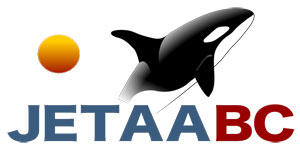
Justin’s Japan: Interview with cartoonist Adam Pasion on ‘Aftershock’ and ‘Sundogs’
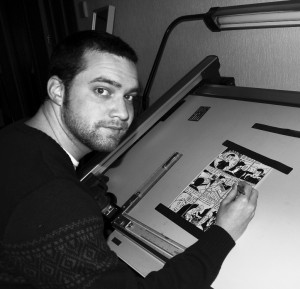
"'Aftershock' is supposed to communicate how far-reaching the influence of Japan has been on cartoonists all over the world, and how we feel in a moment like this. I guess more than an open letter, it's a get well card." (Courtesy of Adam Pasion)
By JQ magazine editor Justin Tedaldi (CIR Kobe-shi, 2001-02) for Examiner.com. Visit his page here for related stories.
For the past several years Adam Pasion has been living in Nagoya, which he calls “Japan’s best kept secret.” An editor and illustrator for RAN magazine, he is also a co-owner and English teacher of SpeakEasy Language School. As the creator of his own comic diary series Sundogs, the San Jose native was profiled in The Japan Times earlier this year, and the strip has since been collected into three books, providing a daily document of Pasion’s life in Nippon with his growing family from 2008 through 2010.
His latest project is Aftershock: Artists Respond to Disaster in Japan, a global response to the combined disasters of this year’s Tohoku earthquake, tsunami and nuclear meltdown. Edited and complied by Pasion and representing over 35 contributors from five continents, including Jeffrey Brown, Ben Snakepit, and JET alum Lars Martinson (Fukuoka-ken, 2003-06), the book shares their thoughts and feelings about a freshly devastated Japan in manga form. In this exclusive interview, Pasion reveals the inspiration for this unique project, his favorite Sundogs moments, and what’s next on his plate.
Tell us about your history with Japan. How did it cross your radar growing up?
My hometown had a pretty big and vibrant Japantown, and we would often go there and eat or go window shopping as a kid, but beyond that Japan was just a point on a map for me. In college I worked with a Japanese girl who tried to get me to go to some club for Japanese exchange students. I reluctantly went and was surprised by how much I enjoyed it—tons of delicious Japanese food and lots of cute girls. I started going regularly, and that is where I met my wife. I started taking a Japanese class, and through that class I got offered a position working in Japan for a summer. After spending a summer working here, I fell in love with the place. Several years later, my wife and I found out that we were going to be having a baby, and we decided to come have the baby close to my wife’s family here in Nagoya. Four years, two kids and a couple belt sizes later, and we are still here.
How did Aftershock come together following the earthquake and tsunami of March 2011?
Like most people out there who have any sort of connection to Japan, I felt paralyzed by the whole thing. Here were all these terrible events unfolding just a few hundred miles up the coast and there was nothing I could do about it. I had a sort of “survivor’s guilt” by proxy. When the medical teams and disaster relief groups started to come in I felt even more uneasy, realizing that it was in fact possible to help, just impossible for me to help. Every place I looked told me “just donate money for now.” I felt like I was sitting in the waiting room, waiting for the doctors to do their job. All I could do was wait, and offer to help with the hospital bills.
Then one night my brain was racing as I was trying to go to sleep, and the idea occurred to me to find a way to help out within my own skill set, which is where the idea for this book came about. I jumped out of bed and immediately fired off about 10 e-mails to the cartoonists I knew personally, and the response was 100 percent positive. I contacted Top Shelf Productions after that on a whim and they were into the idea right away. I still felt like any moment it would vanish in smoke until out of the blue I started getting tons of requests to join the project and submissions from people I had never met. The word had gotten out and was spreading quickly, and at that point I knew we were on to something. When things with Top Shelf didn’t pan out, the project already had way too much momentum to give up, which is why I decided to self-publish it. When the book was funding on Kickstarter, I actually had people thanking me for the chance to pledge money to the project. I still can’t wrap my head around that.
What are your goals with releasing Aftershock?
This has been a major point of misunderstanding from a lot of people. The main goal of this project is not fundraising for a charity. That is certainly a big part of it, but the distinction is that even if it fails to make a lot of money, I think it is incredibly meaningful in its own right. From the beginning I have described this book as a kind of “open letter” to the nation of Japan from the international comics community. It is supposed to communicate how far-reaching the influence of Japan has been on cartoonists all over the world, and how we feel in a moment like this. I guess more than an open letter, it’s a get well card. It is also a timepiece that encapsulates the popular sentiment of the world at one moment. I want all the contributors to look back on this book and remember exactly where we were and how we felt while we were still in the thick of it. I think we have succeeded in this goal. We have created a lasting piece of art that captures an important moment in time and the zeitgeist that goes along with it.
Some people have misunderstood the purpose of the project as a way to donate to the disaster. It certainly is [all proceeds from Aftershock will be donated to relief efforts in northeast Japan—Ed.], but if your main purpose is to make a donation, then there are much more direct ways to do it than to buy this book. I want the book to be successful in its aim to raise as much money as possible to help in the rebuilding process, but I also want people to actively become involved. Read the stories and see why we care so much. I want it to motivate people to join the process of rebuilding and I want it to help people feel like we are all in this thing together.
For the complete story, click here.
JQ Magazine: Book Review – ‘Aftershock: Artists Respond to Disaster in Japan’
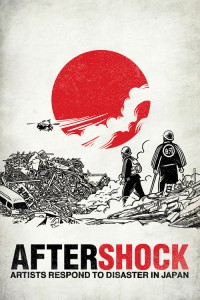
“I assumed a response to the earthquake would be grim. I was, however, relieved to see that there is a nice dose of playfulness alongside the serious, an homage to resilience and the inimitable Japanese sense of humor.” (Big Ugly Robot Press)
By Sharona Moskowitz (Fukuoka-ken, 2000-01) for JQ magazine. Sharona works at a literary agency in New York City. She is interested in fresh, new voices in fiction and creative nonfiction.
Composed in the wake of the catastrophic events of 3/11, Aftershock is something of a series of love letters to Japan written in the object of affection’s own familiar dialect: manga. Edited and compiled by American-born and Nagoya-based cartoonist Adam Pasion (Sundogs), the range of over 35 artists/admirers runs the gamut from the seasoned foreign resident to the casual Japanophile, each with an individual style and tone. The pieces are as eclectic as the artists’ experiences and personal ties to Japan, and all proceeds from Aftershock will be donated to relief efforts in northeast Japan.
When I first approached the anthology I wasn’t sure what to expect though I braced myself for gravity. Even in the form of manga, I assumed a response to the earthquake would be grim. I was, however, relieved to see that there is a nice dose of playfulness alongside the serious, an homage to resilience and the inimitable Japanese sense of humor.
For example, “I Was a Teenage Otaku” by JET alum and Tohonharu cartoonist Lars Martinson (Fukuoka-ken, 2003-06) traces the trajectory of the author’s interest in manga and anime, a hobby which “provided the spark that made [him] want to get out there and really explore” and eventually led to his move to Japan as an exchange student. Though his passion for the art form eventually waned, it gave way to a much broader appreciation of the Japanese arts in general.
JET alum George Rose quoted in NYT feature on Hideki Irabu
JET alum George Rose (Fukushima-ken, 1989-91), former interpreter for Hideki Irabu as well as former JETAA NY President, is quoted in a Sunday, October 9 feature article “Irabu Got Lost on the Way Back“) in the New York Times about Japanese pitcher Hideki Irabu who recently committed suicide. The article gives the impression that George was one of the few U.S. baseball colleagues who actually got to know Irabu personally.
Below is a link to the full article along with the quotes by George:
“When I saw him last summer, he told me he was having a midlife crisis,” said George Rose, who befriended Irabu when he worked for two years as his interpreter on the Yankees. Rose then repeated what had been a kind of conventional wisdom about the Irabu: he had a big heart, but could be his own worst enemy.
**********
“He was kind of searching for what to do next,” said George Rose, his old interpreter, “and he never did.”
For additional background on George, here’s a link to a 2008 JETAANY Newsletter interview with George Rose (“Pride of the Yankees: Far East Edition“) by Stacy Smith (Kumamoto-ken CIR, 2002-03).
Return on JET-vestment: AJET Chair Matthew Cook on the recent 25th Anniversary JET Programme Symposium
*****************
Originally posted to the AJET website by National AJET Chair Matthew Cook (Osaka) who was an attendee of the 25th Anniversary JETProgramme Symposium, where, notably, JET alum Jim Gannon (Ehime-ken, 1992-94), Executive Director of the Japan Center for International Exchange (JCIE/USA), was invited to speak about the JET Programme and the JET Alumni Association.
It’s been a significant month in the world of the JET Programme.
On September 8th, the ministries hosted a commemorative symposium at the University of Tokyo to discuss 25 years of the JET Programme; what it has accomplished, and what challenges it faces today. The symposium featured many notable
speakers, such as United States ambassador to Japan, John Roos, and Ms. Yoko Kimura, the Chair of the Board of Directors of CLAIR.
On behalf of AJET, myself and AJET council members Mark Noizumi (treasurer) and Amelia Hagen (Block 10 rep) attended. After brief opening statements by the ministry heads, many speakers were given the chance to spotlight JETs’ achievements, and voice issues pertinent to the program.
One issue, for Japan as a country, that repeatedly came up was the fact that the number of Japanese students who study abroad or attend universities in foreign countries has been on a steady decline for years. This is particularly troubling in light of Japan’s efforts to globalize as more and more businesses are enforcing English as a required standard.
A highlighted concern for the JET Programme itself was the increasing number of Boards of Education who hire ALTs privately, or through recruiting companies other than JET. One of the many challenges the programme faces is how to best promote the value of what we do, and the return on investment that we can provide to the communities we serve.
As the Chair of AJET, I am fortunate enough to work with many people who have done amazing things with their time on JET. As such, I am aware of the many benefits of the JET programme that are sometimes overlooked. However, this made me question…. is everyone else?
How do we as JETs promote the value of what we do and the return on investment that we provide to the communities we serve?
For example, did you know that over 20 of the employees at the U.S. Embassy in Tokyo are former JETs? Did you know that after the March 11th disasters, current JETs raised an estimated ¥140,000,000 yen towards the relief efforts? These are only two examples of ways that JETs have given back to Japan. The benefits of JET are vast, and the elimination of the program would have far reaching consequences.
Toward the end of the day, the governor of Kyoto made an interesting point that stuck in my mind. He said that he believes the competition of privately hired JETs and the decrease of requests for JETs is actually a good thing! He reasoned that this competition would serve as a stimulus for positive change in our programme to become better and to show more quality than it ever has in the past.
That’s when I realized…. We ARE the positive change in the system now. As we speak, AJET has been working on more ways to provide resources to make JETs better teachers. Ways to learn Japanese more fluently. Opportunities to develop ourselves professionally in the field of education.
Not only that, but we’re finding better ways to connect to each other online and in person via social media and larger scale, better planned volunteer efforts! We’re finding better ways to let JETs VOICE their opinions and concerns to the not only the ministries, but to the people we interact with in our communities and workplaces everyday!
So, do we need to wait for the ministries to “save JET”? Should we wait for JET Alumni to prove that the Programme is a world-renowned program, that should be held in the highest regard so that we have luck with future employers?
No.
We need look no farther than to ourselves for this. We ARE the future of JET. Current JETs lay the ground-work for our successors who come next to fill our shoes.
I feel honored to have attended a symposium of so many people who have made amazing contributions to the JET Programme, and who all have a stake in its survival. I think we should take this symposium as a reminder that now
is the time for us to make more of this experience. The time is now for us to work together to be something MORE. I personally can’t wait to get started making that happen. I hope you’ll join us.
Matthew Cook
National AJET Chair
Symposium Speakers
Jim Gannon
Former JET and Executive
Director of the U.S.
based Japan Center for
International Exchange.
Keiji Yamada
Governor of Kyoto
Prefecture, President of
the National Governors
Association
Masao Niisato
Professor at Tokyo
International University
Angus Lockyer
Chair of Japan’s Research
Centre, University of
London
Jin Ah Kim
Director of International
Cooperation Department,
Governors Association of
Korea
Yoko Kimura
The Chair of the Board of
Directors, CLAIR
Akira Nakamura
Emeritus Professor
Return to Tohoku: “Don’t Speak, Just Move On” by Audrey Shiomi
*******************
The following is a personal essay by Audrey Shiomi (CIR Miyagi-ken, Sendai-shi, 1999-2001). Through generous sponsorship by Japan’s Ministry of Foreign Affairs, she spent a week in September visiting her former residence in Sendai City, one of the areas affected by the March 11 earthquake. In lieu of volunteering in disaster-stricken regions, she spent each day meeting with friends and former coworkers to listen to their stories.
Click here to read other Return To Tohoku updates on JETwit. You can also check the JETAA USA website post (“JET Alums Return to Tohoku”) for additional information.
Don’t Speak, Just Move On
By Audrey Shiomi (CIR Miyagi-ken, Sendai-shi, 1999-2001)
I couldn’t believe how normal it all felt to spend each day hanging out with old friends in Sendai. They hardly talked about what had happened six months ago, and if they did, they were calm, reflective and grateful. They didn’t suffer the way they did in the north, along the Pacific coast.
Within city limits, homes were damaged and people were left without running water, electricity and heat soon after the earthquake. It was late winter, and they had no clue when things they’d taken for granted—warmth, hot food and information—would be readily available. The minute it looked like a market was about to re-open, people formed long lines out the door. Luckily, by Day 5, water and electricity had been restored.
Now, six months later, my friends are with me, laughing, drinking and eating like there’s no tomorrow. We were doing everything but dwelling on March 11 and for good reasons. For one, it was simply time to more forward. For another, talking about your own situation made it seem like you were complaining about it, and—as my friend explained—the only people who are socially allowed to lament are those whose loved ones died in the tsunami.
Another reason few people talk about the events of March is that if someone were to mention they temporarily fled the prefecture after the nuclear reactor meltdown, they’d face the silent scorn of their peers. For some, leaving town was a logical safety measure. For others, leaving town was the moral equivalent of abandoning your family. It’s these opposing schools of thought that make it difficult to openly talk to one another. “It’s like in the U.S. where people don’t bring up religion,” said one Japanese friend. “People don’t talk about certain parts of their experiences after the disaster.”
So instead of dwelling in the past, my friends have no option but to move forward. For many of them, March 11 instilled a newfound reason for living. Many have taken up new hobbies and started traveling more. My friend, Nanae, has been making a living by holding private cooking classes at her home. March 11 fueled her to hold more classes. The way she sees it, she’s lucky to be alive, so not living life would be like besmirching the memory of all those who’d died.
I’m glad my friends have emerged from this tragedy with their heads held high. It would have been a sad reunion if they’d greeted me with distressed tears. If they’d told me, “Take me back to the U.S. with you!” I would have stowed them all away in my suitcase. But, no, instead we’re able to share a drink, enjoy great izakaya food and laugh about old times.
That’s the Japan I know.
JET Alum Author Beat 10.05.11
JET Alum Author Beat is a new feature by Ling Tran (Saga-ken, 2009-11) intended to keep readers informed of what various JET alum authors are up to. Contact Ling at jetwit [at] jetwit.com if you’d like to see something included in upcoming posts. She is also interested in providing exposure for aspiring authors/writers among alumni and current JETs – excerpts and updates are all welcome.
- Suzanne Kamata (Tokushima-ken, 1998-90), author of Losing Kei and fiction editor for Literary Mama, reflects on the recent loss of a dear friend through a post about her first sushi experience on Gaijin Mama (a personal blog). Check it out and give some JET support.
- Sam Baldwin Ono (Fukui-ken, 2004-06) hails from the UK and made a life altering decision when he decided to move to Fukui-ken through the JET Program. The quiet facade of inaka Japan gradually revealed its colorful nature, eventually leading Sam to share stories and insights in For Fukui’s Sake: Two years in rural Japan. Whether for reference (newbie JETs, holla!), nostaliga, or reflection – ESID aside – this book is available electronically. If you want to be notified of its hard copy release, click here. Visit the website For Fukui’s Sake for details. (Fukui t-shirts are also available for purchase.)
- Author of The Order of Odd-Fish James Kennedy (Nara-ken, 2004-06) recently did a Q&A with JQ magazine as he will be curating the 90-Second Newbery Film Festival (Nov. 5 @New York Public Library | Nov. 16 @Harold Washington Library, Chicago). Read here.
- Robert Paul Weston’s (Nara-ken, 2002-04) Zorgamazoo will be honored at the Author Banquet of the California Library Association Conference for a California Young Reader Medal on Nov. 12. Details of the upcoming event are available on Weston’s blog. Congratulations!
- What is Japanamerica blogger Roland Kelts (Osaka-shi, 1998-99) reading these days?
- Cartoonist Lars Martinson (Fukuoka-ken, 2003-06) has been busily settling into his new home and schedule in Kameoka, Kyoto. He managed to fit in a brief post after a short hiatus. Eager followers can see how he is doing here – more substantial updates to come!
Return to Tohoku Update 10.04.11
***************
Here are updates from a few more of the 20 Tohoku region JET alumni selected by the Ministry of Foreign Affairs (MOFA) to return to their town to both engage in volunteer efforts and also help document and share what’s going on there.
- Audrey Shiomi (CIR Miyagi-ken, Sendai-shi, 1999-2001) has had some of her excellent writing and observations published in a series titled Tohoku Travelogue (http://rafu.com/news/tag/tohoku-travelogue/) including:
- “Moving On From Tragedy” (Oct 1)
- “Scenes from an Izakaya” (Sept 15)
- “Nearly Swept Away” (Sept 14)
- “Ah Matsushima!” (Sept 11)
- “Signs, Signs, Everywhere!” (Sept 10)
- “Gambarimasu” (Sept 9)
- “The Telephone Booth” (Sept 8)
- “Letters to Sendai” (Sept 8)
- “Ganbarou Nihon!” (Sept 7)
- “Omiyage 101” (Sept 6)
- “To Be Afraid or Not To Be Afraid….” (Sept 2)
- Brent Stirling (Fukushima-ken, Fukushima-shi, 2006-10) – “Why This is Only Blog #3.5” – Brent tries to explain the overwhelmingness of visiting Soma and how it has affected his approach to blogging about his trip. He shares photos and questions why he has taken them.
- Sharon Van Etten (CIR Iwate-ken), President of JETAA Sydney, has blogged about her trip here: Revisiting Iwate: http://revisitingiwate.blogspot.com/ Here are some recent posts:
Click here to read other Return To Tohoku updates on JETwit. You can also check the JETAA USA website post (“JET Alums Return to Tohoku”) for additional information.
JQ Magazine: Japan Society Launches Beer Revolution

Green Tea IPA, one of over 20 beers ready for tasting at Japan Society's Beer Revolution event Oct. 5. (Courtesy Baird Brewery)
By Vlad Baranenko (Saitama-ken, 2000-02) for JQ magazine. Vlad is an avid photographer.
With an exploding market for craft beer here in the U.S., Japan’s contribution to the industry, known domestically as ji bīru (地ビール), has seen tremendous growth over the past 17 years.
On Oct. 5, beer buffs and those who simply enjoy an occasional cold pint alike will get an opportunity to sample from at least 20 kinds of beer at New York’s Japan Society‘s “Japan’s Beer Revolution: The Birth, Death, and Resurrection of Japanese Craft Brewing.”
While previously held back by government regulation, Japan’s microbreweries took off in 1994, and have since been experimenting with a variety of traditional ingredients such as ginger and oysters to create rich and complex flavors to replace the standard lagers in order to satisfy local taste palettes. Since many of the beers are produced in age old sake breweries, the Japanese had no trouble adapting Western methods to manufacture a product whose quality would no doubt impress even the pickiest connoisseurs of Belgian brew.

